|
|
|
Sort Order |
|
|
|
Items / Page
|
|
|
|
|
|
|
| Srl | Item |
| 1 |
ID:
146805
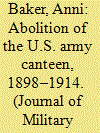

|
|
|
|
|
| Contents |
In the 1880s, the U.S. Army established on-post canteens as a way of curbing excessive drinking in off-post taverns. Army officers supported the canteen concept, but when large numbers of citizen volunteers entered the army in 1898, the temperance movement, particularly the Women's Christian Temperance Union (WCTU), successfully advocated for the canteen’s abolition. The ensuing public debate revealed contesting popular images of soldiers: innocent boys or adult men. The canteen debate focused the attention of Progressive Era activists on moral and social conditions in the army, and engendered a long debate over the role of the army in American society.
|
|
|
|
|
|
|
|
|
|
|
|
|
|
|
|
| 2 |
ID:
102301


|
|
|
| 3 |
ID:
131718
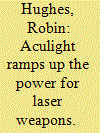

|
|
|
|
|
| Publication |
2014.
|
| Summary/Abstract |
The US army's drive toward a benchmark 100KW class mobile laser combat weapon system edged a step closer with the space and missile defence command (SMDC) award of a contract to Lockheed Martin for the development and manufacture of a 60KW high energy laser (HEL) effector.
|
|
|
|
|
|
|
|
|
|
|
|
|
|
|
|
| 4 |
ID:
162201


|
|
|
| 5 |
ID:
106622
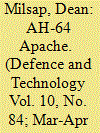

|
|
|
| 6 |
ID:
120285
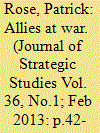

|
|
|
|
|
| Publication |
2013.
|
| Summary/Abstract |
This article compares the philosophy and practice of command in the British and US Armies during the Italian Campaign of 1943-44. It assesses pre-war influences on the command approach adopted by each army, and shows how refinements derived from wartime experience enabled British and American commanders to successfully utilise mission command principles to outfight the German Army in the latter years of World War II. This examination directly challenges the historical consensus that Allied commanders were disadvantaged by an inability to exploit the advantages of mission command, and that the German Army retained superior command practices, despite its other failings, throughout the fighting between 1939 and 1945. These conclusions hold additional relevance to modern military organisations which have emphasised mission command as the optimal solution to effective command in battle since the 1980s, but from an inaccurate understanding of German, British and American command traditions and experience that persists to this day.
|
|
|
|
|
|
|
|
|
|
|
|
|
|
|
|
| 7 |
ID:
127727


|
|
|
|
|
| Publication |
2014.
|
| Summary/Abstract |
In the past three years, NATO countries have cut $120 billion from their combined defence budgets, and they are set to fall further in the next decade. In the US, the Budget Control Act will, by 2021, cut US government spending by $1 trillion much of which will come from defence cuts. US Defence Secretary, Chuck Hagel, said in 2013 that one of the least drastic ways of reaching cuts needed by the sequester would see up to 70,000 less active personnel in the US Army and up to 65,000 less in army reserves. The US Air Force could lose some 25,000 personnel because of sequester, along with 550 aircraft, according to USAF Secretary Eric Fanning.
|
|
|
|
|
|
|
|
|
|
|
|
|
|
|
|
| 8 |
ID:
133668
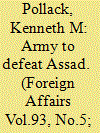

|
|
|
|
|
| Publication |
2014.
|
| Summary/Abstract |
Washington's current efforts to resolve the conflict in Syria will not break the stalemate. The only way to restore peace without committing U.S. troops is to build a new Syrian army capable of defeating both the Assad regime and the extremists.
|
|
|
|
|
|
|
|
|
|
|
|
|
|
|
|
| 9 |
ID:
130048


|
|
|
|
|
| Publication |
2014.
|
| Summary/Abstract |
The role of unacknowledged classified programs remains an enigma for fully understanding activities in space and the study of astropolitics. Classified programs by law are not publicly announced, and remain inaccessible to all except those with valid security clearances to be briefed about them. In the United States, waived Unacknowledged Special Access Programs are the most highly classified programs conducted by the military and intelligence community. The same classification protocols are also required of private contractors working with U.S. military departments and intelligence agencies on classified programs. As space continues to grow in its national security significance, the number of these unacknowledged programs pertaining to space is likely to grow significantly from its current number. This requires adopting the necessary conceptual tools and methodological flexibility for investigating unacknowledged activities in space. This also extends to evidence concerning unidentified flying objects and extraterrestrial life. This article suggests that "exopolitics" is a unique multidisciplinary approach to extraterrestrial life that offers a helpful set of conceptual tools for studying unacknowledged space activities, and complements the field of astropolitics.
|
|
|
|
|
|
|
|
|
|
|
|
|
|
|
|
| 10 |
ID:
129358
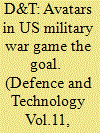

|
|
|
|
|
| Publication |
2012.
|
| Summary/Abstract |
After years of agitating for this sort of thing US army troops have finally convinced the brass to create a realistic war gate where each game character (or Avatar) would not just represent the soldier playing the game.
|
|
|
|
|
|
|
|
|
|
|
|
|
|
|
|
| 11 |
ID:
149398
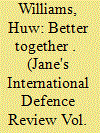

|
|
|
| 12 |
ID:
116800
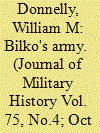

|
|
|
|
|
| Publication |
2011.
|
| Summary/Abstract |
A major criticism of the U.S. Army during the Vietnam War is that it suffered from a crisis in command, especially among officers above the company grade level. Most writing on this topic has centered on structural issues, such as post-World War II personnel policies. This article will examine this phenomenon between the Korean and Vietnam wars by comparing contemporary publications and retrospective critiques by veterans with internal Army sources, particularly service schools, the headquarters of the Continental Army Command, and Headquarters, Department of the Army. If a crisis in command existed between 1953 and 1965, did these organizations' leaders recognize it and address it?
|
|
|
|
|
|
|
|
|
|
|
|
|
|
|
|
| 13 |
ID:
130594
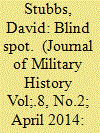

|
|
|
|
|
| Publication |
2014.
|
| Summary/Abstract |
This paper examines why the RAF maintained its view that it would be neither appropriate nor prudent to protect its bombers with long-range fighter escort until the time, late in the day, when the U.S. Army Air Forces' trials to increase the Spitfire fighter's range proved otherwise. The paper argues that some senior RAF officers, who believed that long-range fighters were unnecessary, lacked the conceptual dexterity needed after the RAF's bombers' vulnerability to single-engined fighters became apparent, and that these failings were hidden by a culture of obedience to perceived wisdom that existed within the RAF.
|
|
|
|
|
|
|
|
|
|
|
|
|
|
|
|
| 14 |
ID:
039093
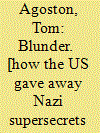

|
|
|
|
|
| Publication |
London, William Kimber & Co Ltd, 1985.
|
| Description |
176p.Hbk
|
| Standard Number |
0-7183-0617-1
|
|
|
|
|
|
|
|
|
|
|
|
Copies: C:1/I:0,R:0,Q:0
Circulation
| Accession# | Call# | Current Location | Status | Policy | Location |
| 028701 | 940.5485/AGO 028701 | Main | On Shelf | General | |
|
|
|
|
| 15 |
ID:
132165
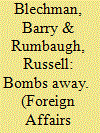

|
|
|
|
|
| Publication |
2014.
|
| Summary/Abstract |
In 1991, U.S. President George H. W. Bush decided to retire almost all the tactical nuclear weapons operated by the U.S. Army and the U.S. Navy. His reasons were simple: these short-range weapons were militarily useless and imposed significant burdens on the armed forces in terms of money, manpower, and time. Twenty-three years later, only one type of tactical nuclear weapon remains in the U.S. inventory: the B-61 gravity bomb. In addition to the several hundred B-61s located at home, the United States currently deploys around 180 of them in Europe, at bases in Belgium, Germany, Italy, the Netherlands, and Turkey. In the event of a nuclear conflict on the continent, NATO would deliver the bombs via U.S.-built F-15 or F-16 aircraft or European-built Tornado fighters, operated by some combination of Belgian, Dutch, German, Italian, and U.S. crews. Originally intended to prevent Soviet forces from penetrating Western Europe, the planes could travel as far east as Russia. But owing to their slower speed and lower altitude, they would be much more vulnerable to Russia's ground-based air defenses than would longer-range strategic bombers and missiles.
|
|
|
|
|
|
|
|
|
|
|
|
|
|
|
|
| 16 |
ID:
126638
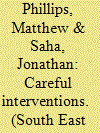

|
|
|
|
|
| Publication |
2013.
|
| Summary/Abstract |
When Ian Brown first visited Thailand in the 1970s, it was a deeply fragmented place. The Vietnam War was raging and US Army personnel dominated downtown Bangkok. In the country's universities, leftists of varying degrees of radicalization fought ideological battles against a conservative military and business elite. Extrajudicial violence was commonplace, and intrigue about the true extent of Communist subversion in the country reigned. It was the height of the Cold War, and there was a palpable sense that ideological forces should be used to determine both the country's future and a correct interpretation of the past.1 So it is notable that Ian's early work not only managed to remain aloof from the political cauldron in which it was written, but that it was so clearly opposed to the historical determinism that was such a prevalent feature of the time
|
|
|
|
|
|
|
|
|
|
|
|
|
|
|
|
| 17 |
ID:
131751
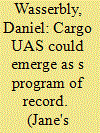

|
|
|
|
|
| Publication |
2014.
|
| Summary/Abstract |
the cargo unmanned aircraft system (UASs) landscape is poised to soon evolve as the systems appear in favour with US Army and US Marine Corps (USMC) planners, and congress is pressing the Pentagon to settle on a program of record for unmanned cargo delivery
|
|
|
|
|
|
|
|
|
|
|
|
|
|
|
|
| 18 |
ID:
187624
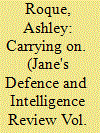

|
|
|
| 19 |
ID:
106624
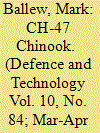

|
|
|
| 20 |
ID:
122538


|
|
|
|
|
| Publication |
2012.
|
| Summary/Abstract |
Modern military uniforms require advanced features, such as thermal and fire resistance, enduring anti microbial protection, and be comfortable while also remaining suitable for the specialist applications asked of them by the military users. Modern textiles are also being compared with much older ones, particularly wool to find the best solution for each mission.
|
|
|
|
|
|
|
|
|
|
|
|
|
|
|
|
|
|
|
|
|